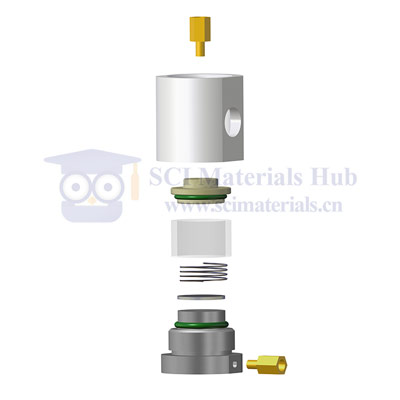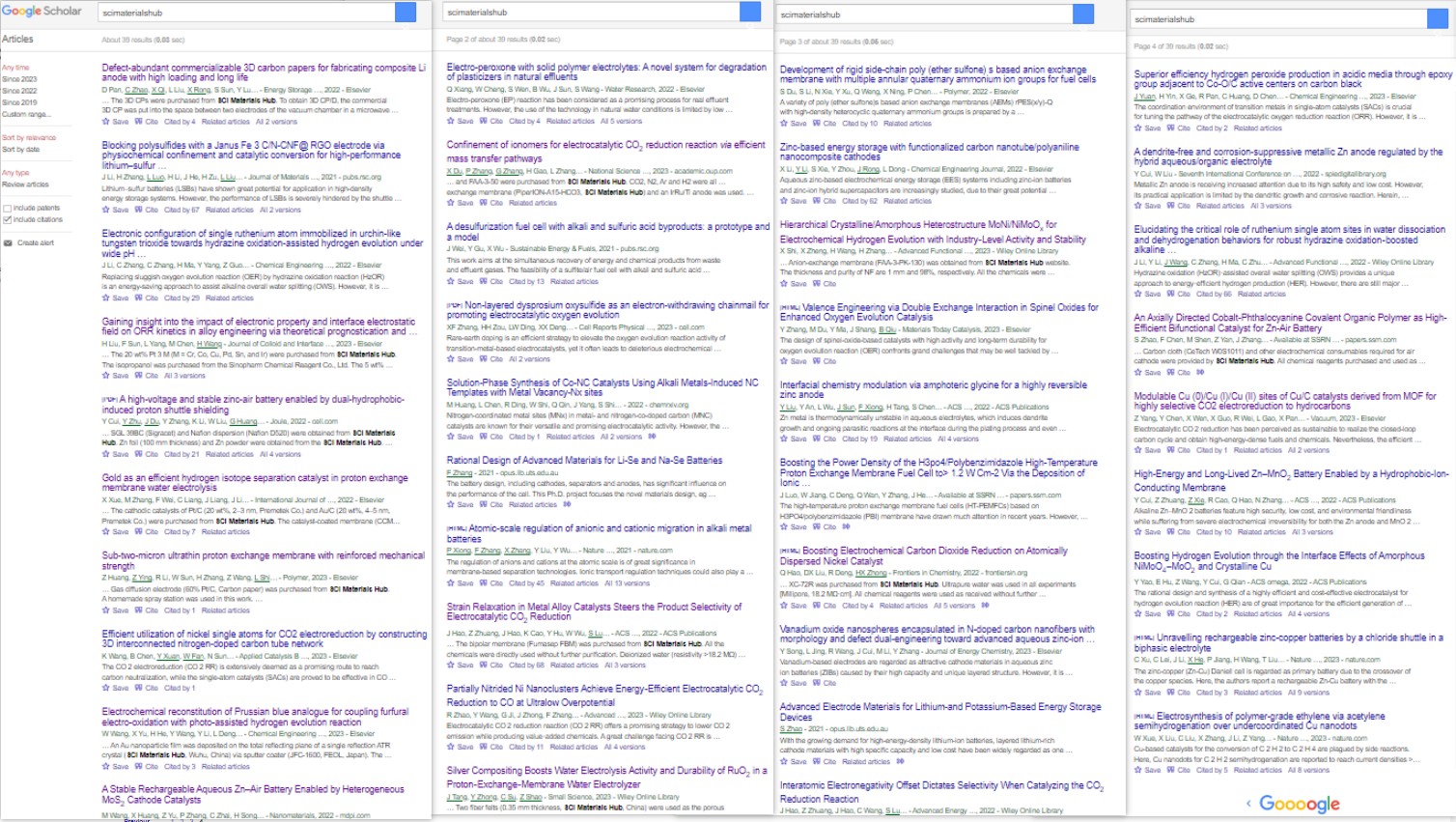
Precision Electrochemical Testing Fixture for Lithium, Sodium, Potassium, and Other Metal Batteries
The Fueiceel® BM02 Observable Battery Testing Hardware (Two-Electrode Type) is a specialized fixture developed by SCI Materials Hub for electrochemical testing of a wide range of metal batteries—including lithium, sodium, potassium, aluminum, magnesium, and calcium cells. It provides a secure and electrically reliable setup for evaluating battery performance, cycling, and safety.
Electrode area: Φ6 mm to Φ20 mm (Φ16 mm standard)
Custom sizes: Available upon request
Application: Designed for use in glove boxes with compact, airtight, and ergonomic construction, ensuring repeatability and easy operation.
Users can freely select different materials for the housing and conductive parts depending on the experiment. The polymer-based body is highly resistant to corrosive solvents, ensuring excellent chemical durability and long service life.
✅ High-Precision Clamping: Securely fixes battery electrodes to ensure reliable measurements and prevent contact errors during electrochemical tests.
✅ Superior Electrical Conductivity: Contact components are made from stainless steel, gold-plated stainless steel, corrosion-resistant titanium, or gold-plated titanium, offering stable signal transmission and excellent corrosion resistance.
✅ Robust and Chemically Stable Design: Withstands high temperatures and harsh testing environments, maintaining long-term mechanical and electrical performance.
✅ Flexible Battery Compatibility: Supports various battery types and sizes (Φ6–Φ30 mm), including Li, Na, K, Al, Mg, Ca systems.
✅ Real-Time Observation Window: Equipped with a transparent observation port (Φ10 mm for standard Φ16 mm models) for visual monitoring of battery behavior during operation.
🔗 System Integration: Ready-to-connect with potentiostats, LAND, Neware, Arbin, etc.
🔋 Battery Performance Testing: Connects seamlessly to test equipment to evaluate battery voltage, current, capacity, energy density, and internal resistance.
🔁 Cycle Life Testing: Maintains stable contact throughout long-term cycling tests to generate accurate and reproducible lifetime data.
🔥 Safety & Abuse Testing: Ideal for testing under overcharge, over-discharge, and thermal runaway conditions where stable electrical contact is critical.
🧫 Membrane Conductivity Testing: Also suitable for measuring the ionic conductivity of membranes or solid electrolytes in R&D.
Ensure Clean and Conductive Contacts: Always inspect contact points before testing to avoid inaccurate readings.
Prevent Short Circuits: Carefully manage positive/negative terminal separation during handling.
Regular Maintenance: Periodically check and clean the fixture to prolong its service life and preserve data accuracy.
The Fueiceel® BM02 Two-Electrode Testing Fixture is a critical tool for battery research and development, offering precision, durability, and customizability. Whether you're testing new chemistries or optimizing existing cells, this fixture ensures stable, reproducible, and accurate electrochemical performance data in laboratory or glovebox environments.
📦 Ready Stock | Custom Sizes Available | Fast Dispatch
📧 Email: contact@scimaterials.cn
📱 WeChat: SCI-Materials-Hub
📞 WhatsApp: +86-15357899751

For international orders, please ask us for quotes via
Email: contact@scimaterials.cn
Tel: +86 15375698751
Wechat: SCI-Materials-Hub
Clik here to put quick orders on our ebay/Amazon stores
📌 For Li/Na/K/Mg metal battery testing (performance, cycle life, conductivity)
🔗 Compatible with Gamry, CHI, Autolab, Zahner, LAND, Neware, etc.
| Model | Description | Conduction Components Material | Case Material | Temp. Range (°C) | Price (USD) |
|---|---|---|---|---|---|
| BM02-1 | Standard battery fixture | 316L stainless steel | ABS | -30 to 100 | $57 |
| BM02-2 | Corrosion-resistant version | Titanium (Ti) | ABS | -30 to 100 | $114 |
| BM02-3 | Enhanced corrosion resistance | Molybdenum (Mo) | ABS | -30 to 100 | $143 |
| BM02-4 | High conductivity | Gold-plated stainless steel | ABS | -30 to 100 | $143 |
| BM02-5 | High conductivity + corrosion-resistant | Gold-plated Ti | ABS | -30 to 100 | $229 |
| BM02-6 | High/low temperature version | 316L stainless steel | PTFE | -200 to 200 | $86 |
| BM02-7 | High/low temp. + corrosion-resistant | Titanium (Ti) | PTFE | -200 to 200 | $143 |
| BM02-8 | High/low temp. + enhanced corrosion | Molybdenum (Mo) | PTFE | -200 to 200 | $171 |
| BM02-9 | High/low temp. + high conductivity | Gold-plated stainless steel | PTFE | -200 to 200 | $171 |
| BM02-10 | High/low temp. + high cond. + corrosion | Gold-plated Ti | PTFE | -200 to 200 | $257 |
| Custom | PEEK (300 °C), PI (400 °C), PFA (X-ray clear) | Custom | Custom | Custom | Contact Us |
Conductive terminal posts ×2
Upper/lower conductive rods ×1 each (material-dependent)
Conductive spacer ×1
Spring ×1
Battery shell ×2 (ABS or PTFE)
Sealing O-rings ×2
Transparent observation chamber ×1
Crocodile clip wire ×1 pair
| Item | Options & USD Price |
|---|---|
| Spring | 304L ($1.5) / 316L ($2) / Titanium ($7) |
| Reaction chamber | ABS ($29) / PTFE ($36) / PEEK ($43) / PFA, PI ($114) |
| Others | Crocodile clip wire ($3/pair), Post ($1/pc), Screw ($0.5/pc) |
Electrode Size: Φ6 mm – Φ20 mm (round or square)
Materials Supported: Cu foil, Al foil, nickel foam, carbon cloth/paper, graphite felt, freestanding films
Electrode Thickness: 0.05 mm – 20 mm
Shell Options: PEEK (300 °C), PI (400 °C), PFA (X-ray transparent)
Compatible With: Electrochemical workstations & battery testers (LAND, Neware)
📞 Contact for Orders / Technical Support
📧 Email: contact@scimaterials.cn
💬 WeChat: SCI-Materials-Hub
📱 WhatsApp: +86-15357899751
🛒 Modular ' Anti-corrosion ' Customizable ' Lab Essential – Order Now!
Worldwide shipping via DHL, SF-Express & other requested carriers.
Payments via Bank Transfer, Paypal, Credit card (via Alibaba), Alipay, Wechat-pay are accepted.
Partial references citing our materials (from Google Scholar)

Carbon Dioxide Reduction
1. ACS Nano Strain Relaxation in Metal Alloy Catalysts Steers the Product Selectivity of Electrocatalytic CO2 Reduction
The bipolar membrane (Fumasep FBM) in this paper was purchased from SCI Materials Hub, which was used in rechargeable Zn-CO2 battery tests. The authors reported a strain relaxation strategy to determine lattice strains in bimetal MNi alloys (M = Pd, Ag, and Au) and realized an outstanding CO2-to-CO Faradaic efficiency of 96.6% with outstanding activity and durability toward a Zn-CO2 battery.
2. Front. Chem. Boosting Electrochemical Carbon Dioxide Reduction on Atomically Dispersed Nickel Catalyst
In this paper, Vulcan XC-72R was purchased from SCI Materials Hub. Vulcan XC 72R carbon is the most common catalyst support used in the anode and cathode electrodes of Polymer Electrolyte Membrane Fuel Cells (PEMFC), Direct Methanol Fuel Cells (DMFC), Alkaline Fuel Cells (AFC), Microbial Fuel Cells (MFC), Phosphoric Acid Fuel Cells (PAFC), and many more!
3. Adv. Mater. Partially Nitrided Ni Nanoclusters Achieve Energy-Efficient Electrocatalytic CO2 Reduction to CO at Ultralow Overpotential
An AEM membrane (Sustainion X37-50 Grade RT, purchased from SCI Materials Hub) was activated in 1 M KOH for 24 h, washed with ultra-purity water prior to use.
4. Adv. Funct. Mater. Nanoconfined Molecular Catalysts in Integrated Gas Diffusion Electrodes for High-Current-Density CO2 Electroreduction
In this paper (Supporting Information), an anion exchanged membrane (Fumasep FAB-PK-130 obtained from SCI Materials Hub (www.scimaterials.cn)) was used to separate the catholyte and anolyte chambers.
SCI Materials Hub: we also recommend our Fumasep FAB-PK-75 for the use in a flow cell.
5. Appl. Catal. B Efficient utilization of nickel single atoms for CO2 electroreduction by constructing 3D interconnected nitrogen-doped carbon tube network
In this paper, the Nafion 117 membrane was obtained from SCI Materials Hub.
In this paper, Proton exchange membrane (Nafion 117), Nafion D520, and Toray 060 carbon paper were purchased from SCI Materials Hub.
7. National Science Review Confinement of ionomer for electrocatalytic CO2 reduction reaction via efficient mass transfer pathways
An anion exchange membrane (PiperION-A15-HCO3) was obtained from SCI Materials Hub.
8. Catalysis Communications Facilitating CO2 electroreduction to C2H4 through facile regulating {100} & {111} grain boundary of Cu2O
Carbon paper (TGPH060), membrane solution (Nafion D520), and ionic membrane (Nafion N117) were obtained from Wuhu Eryi Material Technology Co., Ltd (a company under SCI Materials Hub).
Batteries
1. J. Mater. Chem. A Blocking polysulfides with a Janus Fe3C/N-CNF@RGO electrode via physiochemical confinement and catalytic conversion for high-performance lithium–sulfur batteries
Graphene oxide (GO) in this paper was obtained from SCI Materials Hub. The authors introduced a Janus Fe3C/N-CNF@RGO electrode consisting of 1D Fe3C decorated N-doped carbon nanofibers (Fe3C/N-CNFs) side and 2D reduced graphene oxide (RGO) side as the free-standing carrier of Li2S6 catholyte to improve the overall electrochemical performance of Li-S batteries.
This paper used more than 10 kinds of materials from SCI Materials Hub and the authors gave detailed properity comparsion.
The commercial IEMs of Fumasep FAB-PK-130 and Nafion N117 were obtained from SCI Materials Hub.
Gas diffusion layers of GDL340 (CeTech) and SGL39BC (Sigracet) and Nafion dispersion (Nafion D520) were obtained from SCI Materials Hub.
Zn foil (100 mm thickness) and Zn powder were obtained from the SCI Materials Hub.
Commercial 20% Pt/C, 40% Pt/C and IrO2 catalysts were also obtained from SCI Materials Hub.
3. Journal of Energy Chemistry Vanadium oxide nanospheres encapsulated in N-doped carbon nanofibers with morphology and defect dual-engineering toward advanced aqueous zinc-ion batteries
In this paper, carbon cloth (W0S1011) was obtained from SCI Materials Hub. The flexible carbon cloth matrix guaranteed the stabilization of the electrode and improved the conductivity of the cathode.
4. Energy Storage Materials Defect-abundant commercializable 3D carbon papers for fabricating composite Li anode with high loading and long life
The 3D carbon paper (TGPH060 raw paper) were purchased from SCI Materials Hub.
5. Nanomaterials A Stable Rechargeable Aqueous Zn–Air Battery Enabled by Heterogeneous MoS2 Cathode Catalysts
Nafion D520 (5 wt%), and carbon paper (GDL340) were received from SCI-Materials-Hub.
Carbon cloth (W0S1011) and other electrochemical consumables required for air cathode were provided by SCI Materials Hub.
Oxygen Reduction Reaction
1. J. Chem. Eng. Superior Efficiency Hydrogen Peroxide Production in Acidic Media through Epoxy Group Adjacent to Co-O/C Active Centers on Carbon Black
In this paper, Vulcan XC 72 carbon black, ion membrane (Nafion N115, 127 μL), Nafion solution (D520, 5 wt%), and carbon paper (AvCarb GDS 2230 and Spectracarb 2050A-1050) were purchased from SCI Materials Hub.
2. Journal of Colloid and Interface Science Gaining insight into the impact of electronic property and interface electrostatic field on ORR kinetics in alloy engineering via theoretical prognostication and experimental validation
The 20 wt% Pt3M (M = Cr, Co, Cu, Pd, Sn, and Ir) were purchased from SCI Materials Hub. This work places emphasis on the kinetics of the ORR concerning Pt3M (M = Cr, Co, Cu, Pd, Sn, and Ir) catalysts, and integrates theoretical prognostication and experimental validation to illuminate the fundamental principles of alloy engineering.
Water Electrolysis
1. International Journal of Hydrogen Energy Gold as an efficient hydrogen isotope separation catalyst in proton exchange membrane water electrolysis
The cathodic catalysts of Pt/C (20 wt%, 2–3 nm) and Au/C (20 wt%, 4–5 nm) were purchased from SCI Materials Hub.
2. Small Science Silver Compositing Boosts Water Electrolysis Activity and Durability of RuO2 in a Proton-Exchange-Membrane Water Electrolyzer
Two fiber felts (0.35 mm thickness, SCI Materials Hub) were used as the porous transport layers at both the cathode and the anode.
3. Advanced Functional Materials Hierarchical Crystalline/Amorphous Heterostructure MoNi/NiMoOx for Electrochemical Hydrogen Evolution with Industry-Level Activity and Stability
Anion-exchange membrane (FAA-3-PK-130) was obtained from SCI Materials Hub website.
Fuel Cells
1. Polymer Sub-two-micron ultrathin proton exchange membrane with reinforced mechanical strength
Gas diffusion electrode (60% Pt/C, Carbon paper) was purchased from SCI Materials Hub.
Characterization
1. Chemical Engineering Journal Electrochemical reconstitution of Prussian blue analogue for coupling furfural electro-oxidation with photo-assisted hydrogen evolution reaction
An Au nanoparticle film was deposited on the total reflecting plane of a single reflection ATR crystal (SCI Materials Hub, Wuhu, China) via sputter coater.

|
We Provide A Broad Range of Materials, Instruments & Solutions in Advanced Science and Technologies | About Us |



